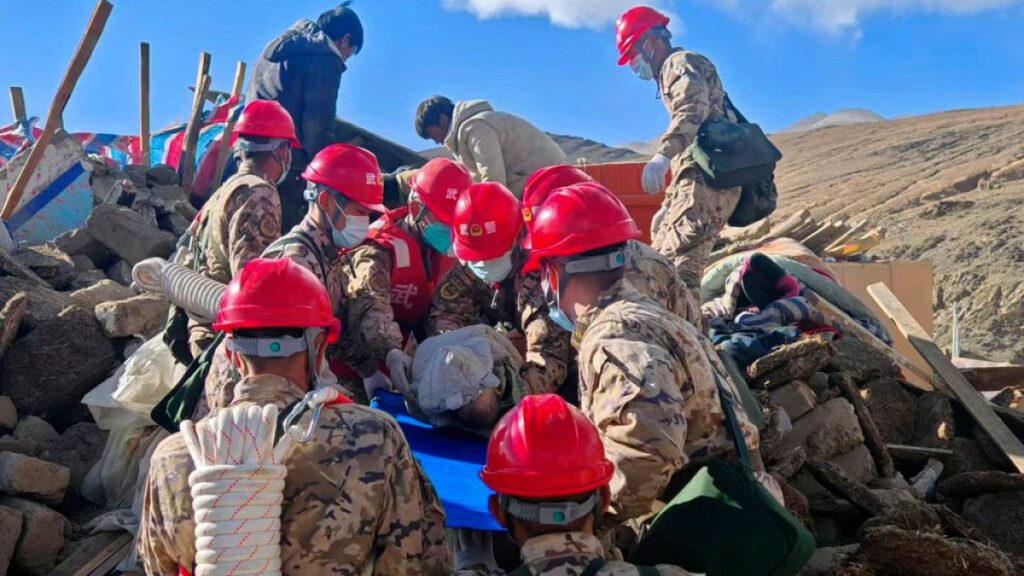Paragraph 1: The Devastating Earthquake and Immediate Aftermath
A powerful 7.1 magnitude earthquake struck the Tibet Autonomous Region of China on Tuesday, leaving a trail of destruction and loss in its wake. The epicenter, situated at a high altitude of approximately 4,200 meters, exacerbated the challenges faced by rescuers and survivors. Initial reports confirmed at least 126 fatalities and nearly 200 injuries, with fears that the death toll could rise as search and rescue operations continue. The earthquake’s impact was widespread, causing the collapse of over 3,600 houses and displacing approximately 30,000 residents. The immediate aftermath saw hundreds of people trapped beneath the rubble, prompting a large-scale rescue effort.
Paragraph 2: Rescue and Relief Efforts in Challenging Conditions
Rescue efforts were swiftly mobilized, with over 1,850 personnel from the Ministry of Emergency Management deployed to the affected areas. Firefighters, local officials, and volunteers joined the rescue teams, working tirelessly to locate and extricate survivors from the debris. The high altitude and freezing temperatures presented significant challenges, adding urgency to the rescue operations. Over 400 trapped individuals were successfully rescued, offering a glimmer of hope amid the devastation. Simultaneously, relief efforts were underway, with tents, quilts, folding beds, and other essential supplies distributed to those displaced by the earthquake, providing temporary shelter and comfort in the harsh conditions.
Paragraph 3: Assessing the Damage and Reaching Remote Villages
The vastness of the affected area complicated the assessment of the full extent of the damage. Rescue teams, including the Xizang Forest Fire Brigade, embarked on a mission to reach remote villages scattered across the region. Their primary objective was to conduct a comprehensive assessment of the disaster situation in each village, identify trapped individuals, and gather preliminary information to guide the larger rescue teams. The challenging terrain and limited accessibility posed obstacles to these efforts, underscoring the need for efficient coordination and resource allocation.
Paragraph 4: Aftershocks and the Geological Context
The initial earthquake was followed by a series of over 500 aftershocks, some registering magnitudes of up to 4.4. These aftershocks further destabilized the region, posing a continued threat to both rescuers and survivors. The earthquake’s epicenter was located in a geologically active zone where the Indian and Eurasian tectonic plates collide. This collision zone is notorious for its seismic activity, making earthquakes a recurring phenomenon in the southwestern regions of China, Nepal, and northern India. The frequent tremors highlight the inherent vulnerability of the region to seismic events.
Paragraph 5: Historical Seismic Activity and Future Preparedness
The historical record of seismic activity in the region underscores the significant earthquake risk. The US Geological Survey reports that over the past century, more than ten earthquakes with magnitudes of 6 or greater have struck this area. This pattern of powerful earthquakes emphasizes the importance of robust disaster preparedness and mitigation strategies. Building codes and infrastructure development must take into account the seismic vulnerability of the region to minimize future damage and loss of life.
Paragraph 6: The Long Road to Recovery
The immediate aftermath of the earthquake has focused on rescue and relief efforts, but the long road to recovery lies ahead. Rebuilding homes, restoring infrastructure, and providing ongoing support to the affected communities will require a sustained and coordinated effort. Addressing the psychological impact of the disaster on survivors will also be crucial. The earthquake serves as a stark reminder of the destructive power of nature and the importance of investing in disaster preparedness and resilience in vulnerable regions. The international community can play a vital role in supporting the recovery process, providing assistance in rebuilding efforts and sharing expertise in disaster management.














